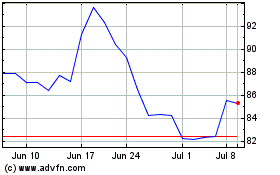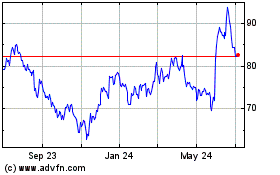The Tricky Math Of Black Friday Bargains
November 24 2015 - 3:03AM
Dow Jones News
(FROM THE WALL STREET JOURNAL 11/24/15)
By Suzanne Kapner
Shoppers already are scouring stores for the best holiday deals,
but finding true bargains this season has gotten a lot more
complicated.
The layers of discounts, flash promotions and store coupons are
testing consumers' math skills -- and patience. Nancy Haas, of
Lockport, N.Y., says when retailers pile one deal on top of another
it drives her batty. "I'll get to the register and think I'm
getting a certain discount, and realize, no, that's not what it
is," says the 57-year-old substitute teacher, who has taken to
carrying a calculator, pencil and paper with her.
Deep promotions once reserved solely for the holiday season have
become commonplace year-round as retailers battle to attract
shoppers who are still thrifty six years after the recession.
Consumers have become so accustomed to discounts they are reluctant
to shop without them. America's Research Group found that more than
three-quarters of shoppers want discounts of 60% off before making
a purchase.
This Black Friday, the stakes are even higher. Sluggish retail
sales throughout the fall have left excess goods on store shelves
and forced retailers to ramp up promotions beyond what they had
planned.
"The more prices become convoluted, the less retailers will have
to match lower prices offered by their rivals," said Simeon Siegel,
an analyst with Nomura Holdings Inc.
And price has become a moving target. Amazon changed prices 666
times on 180 popular products sold from Nov. 1 through Nov. 19,
according to Market Track, a price-tracking firm. That is a 51%
increase in price volatility compared with similar products sold
during the same period a year earlier. Wal-Mart Stores Inc.'s
prices changed 631 times and Best Buy Co.'s prices changed 263
times on similar products sold during the same period this
year.
Market Track expects fluctuations to speed up through the
holidays. "We're not at the pinnacle of this volatility yet," said
Traci Gregorski, the firm's vice president of marketing. "It will
get even crazier."
Retailers also use a tactic called stackable promotions, where
more than one discount can be applied to the same item, such as
when a $100 sweater is marked 20% off and then an additional 25%
off. People tend to buy more when promotions are layered, because
they often mistakenly think they are getting a better deal. They
add the two discounts together, rather than taking the second
discount off the reduced price, according to Akshay Rao, a
marketing professor at the University of Minnesota. For that $100
sweater, the discount is 40% off, not 45%.
Stackable deals during last year's Black Friday were up about
30% compared with 2013, according to a database of more than
500,000 coupons compiled by website RetailMeNot Inc. Yet, the
stackable deals didn't provide greater savings. Both the layered
deals and the flat deals worked out to discounts of roughly
40%.
Shoppers also have a tendency to get confused over whether a
dollar amount versus a percentage off is the better deal.
Citi Retail Services, a unit of Citigroup that provides
private-label credit cards to retailers, tested two offers this
year with thousands of customers. One gave a fixed $20 off the
first purchase made with a credit card. The other gave 30% off.
Most customers chose the fixed $20 off, even though the 30%
discount provided greater savings because most first purchases
exceed $100, according to Leslie McNamara, Citi Retail Services'
managing director.
Some retailers have been accused of pushing the envelope on the
way they price products. J.C. Penney Co. and Michael Kors Holdings
Ltd. both recently agreed to settle class-action lawsuits that
accused them of using higher base prices to inflate their
discounts. In January, four members of Congress asked the Federal
Trade Commission to investigate potentially deceptive pricing by
outlet stores.
In the case against Penney, lead plaintiff Cynthia Spann claimed
the 40% discount she received on three blouses she bought at $17.99
a piece was misleading because none of them had sold for the
regular retail price of $30 in the preceding three months.
According to the Federal Trade Commission, retailers are
supposed to offer items at regular prices "for a reasonably
substantial period of time" before marking them down. Penney denies
the allegations but earlier this month agreed to settle the case
for $50 million to eliminate the uncertainties and expense of
further litigation.
In September, Michael Kors agreed to pay $4.9 million to settle
claims it used fake manufacturer's suggested retail prices at its
outlet stores to make the discounts appear deeper than they
actually were. The lawsuit contended that many products were made
exclusively for the outlet stores and were never sold at the list
price. Michael Kors says its pricing isn't deceptive.
TJX Cos., Amazon.com Inc., Kohl's Corp. and Nordstrom Inc. are
facing similar lawsuits. A Nordstrom spokeswoman said the lawsuit
had no merit. She said the company is committed to "pricing
integrity" and that items sold at its off-price Nordstrom Rack
stores "are not lesser quality versions of original items."
Representatives for Amazon and Kohl's declined to comment.
A TJX spokeswoman declined to comment on the litigation, but
said the company explains its pricing at its stores and on its
website this way: "Our 'compare at' price is based on our buying
staff's estimate of the regular, retail price at which a comparable
item in finer catalogs, specialty or department stores may have
been sold."
Subscribe to WSJ: http://online.wsj.com?mod=djnwires
(END) Dow Jones Newswires
November 24, 2015 02:48 ET (07:48 GMT)
Copyright (c) 2015 Dow Jones & Company, Inc.
Best Buy (NYSE:BBY)
Historical Stock Chart
From Mar 2024 to Apr 2024

Best Buy (NYSE:BBY)
Historical Stock Chart
From Apr 2023 to Apr 2024
